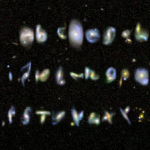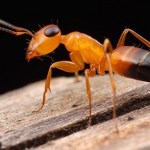photographs
"When I was having that alphabet soup, I never thought that it would pay off." -Vanna White
Ever want an A-to-Z illustrated alphabet of astrophysics? Turns out that -- other than writing your own via Galaxy Zoo -- it doesn't yet exist. So I thought it would be delightful to make one for you... right now!
Image credit: Flickr user Image Editor / 11304375@N07.
A is for Aurora, polar lights fast and slow,
the Sun's hot electrons make the atmosphere glow.
Image credit: Andrew Hamilton of JILA / Colorado, http://jila.colorado.edu/~ajsh/insidebh/schw.html.
B is for Black hole, a star'…
New this week at alexanderwild.com we have photographs of the Savanna Strobe Ant Opisthopsis haddoni. These delightfully perky insects inhabit open environments in northern Australia and are one of my favorite ants.
Opisthopsis has excellent vision. The location of the compound eyes atop the head allows it to spot a photographer approaching from any direction and take appropriate evasive action. This wasn't the easiest ant to shoot.
The peculiarly erratic style of walking is also not conducive to photography. The common name "strobe ant" refers to this ant's unpredictable little fits and…
tags: bird behavior, emotional lives of animals, ornithology, birds, avian, photoessay
The bird calls out after realising that his (her?) mate is dead
Image: Wilson Hsu, AbuNawaf.com [larger view].
There are many inexplicable and tragic events in nature, yet few are captured on film. Here is an interesting series of photographs depicting a pair of swallows, Hirundo rustica (known as the Barn Swallow in the United States). In this series of images, we watch the story that unfolds after one of the birds was fatally injured, yet the bird's mate remains nearby, delivering food or water and…
tags: dinosaurs, Tarbosaurus bataar, paleontology, fossils, Tyrannosaurs rex
The newly unveiled fossil skeleton of the juvenile Tarbosaurus bataar in its protective jacket.
Discovered in 2006, a near-perfect complete skeleton of a juvenile Tarbosaurus find was made available for public viewing for the first time today by the Hayashibara Museum of Natural Science in Okayama, western Japan. This fossil was originally unearthed from a chunk of sandstone in the Gobi Desert of Mongolia by a team of Mongolian and Japanese researchers. The fossil of the young dinosaur is roughly 70 million years…
tags: foot binding, China, social behavior, fashion psychology, streaming video
A friend sent these images depicting foot-binding in China. To say the least, I knew this practice was painful and caused permanent malformations, but seeing the damage makes my own feet scream in agony. How did such a strange and harmful behavior like this ever become a cultural fashion/fad/fetish?
An elderly Chinese woman who was one of the countless victims of foot-binding. She can barely stand or walk, even with assistance. Gee, I wonder why?
An elderly Chinese woman, one of countless millions of female…
tags: lories, loriinae, yellow-bibbed lory, Lorius chlorocercus, parrots, birds, photograph
Odysseus.
Male yellow-bibbed lory, Lorius chlorocercus, April 2008.
Image: GrrlScientist 2008 [larger view].
This parrot is a lory. Lories are a group of nectar-feeding parrots that are from islands in the south Pacific Ocean. This particular species originates on the Solomon Islands. When I lived in Seattle, I had a flock of 8 species (30 individuals) of lories that I bred, raised and trained for most of my life, and I studied the evolution of the lories for my postdoctoral work. When I left…
tags: WTC, World Trade Center, iron cross, NYC, NYCLife
The iron cross, salvaged from Ground Zero after the World Trade Center
was destroyed by terrorists on 11 September 2001,
is located in Inwood, borough of Manhattan, NYC.
Image: GrrlScientist 2008. [wallpaper size].
WTC Iron cross plaque in Inwood, borough of Manhattan, NYC.
Image: GrrlScientist 2008. [wallpaper size].
Female Snow Leopard twins born last year at the Bronx Zoo.
When I initially started posting pictures on my blog, I didn't know if anyone would have anything to say about my pictures. I frequent zoos, museums, and aquariums, usually shooting between 200 and 600 shots per trip, the handful of good shots making their way onto the internet. I've been certainly pleasantly surprised, therefore, to see all the positive remarks made about my pictures, especially since I don't really have any idea what I'm doing. Still, many of you have asked how I have been able to get the kind of shots I've…

